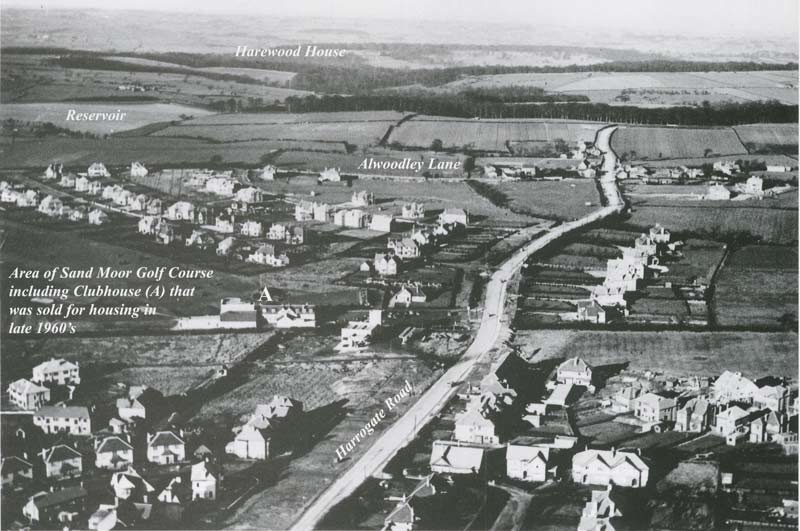AN ILLUSTRATED HISTORY OF ALWOODLEY
The times they are a’changing
The Barran family had played an instrumental role in creating Sand Moor Golf Club but by the early sixties Mrs. Barran indicated that she intended to sell the tongue of land to the south of Alwoodley Lane for housing. The Committee had to act swiftly as this parcel contained not only the clubhouse but also holes 1, 2, 17 and 18. In October 1966 permission was granted for the creation of a new housing estate based on what became Sand Moor Lane. Negotiations with Leeds Corporation Waterworks and Mr.Gilpin, the farmer who was leasing land abutting their course near Goodrick Lane secured enough space to reconstruct the course and the crisis was allayed. The new clubhouse opened on 28 September 1968.137
Sand Moor wasn’t the only club undergoing radical change. When Moor Allerton Golf Club had been created in the twenties open countryside surrounded it on nearly all sides. With the spread of suburban housing estates it had become less desirable as a recreation facility but extremely desirable as prime building land. This fact was not lost on Bernard Lyons, an influential member of the club, who in 1964 learnt that Blackmoor Farm at Wike, plus one hundred and twenty acres, was to be sold by auction.

He sought the help of Irwin Bellow, the Chairman of the Club, to persuade members to sell up and move. There was overwhelming support for the project.
Nevertheless the scheme was not without its difficulties not least whether they could obtain planning permission for housing on the land off Nursery Lane. In 1967 there was a Public Enquiry with the main objections to the scheme coming from Moortown Golf Club and the residents of Nursery Lane and the Primley Park Estate.
The following year the enquiry found in favour of the club and an offer of £490,000 from Laing Homes was accepted for the first parcel of land and a further £65,000 from Cameron Brewery for the Club House which became known as ‘The Allerton’. The new course was ready for use in October 1970.138 The acquisition of this land and that of the former Heath Nursery site led to the development of the Sunningdales, Birkdale, Turnberry and Wentworth estates. The vast number of houses built on this tract of land changed forever the character of Alwoodley. With the removal of this green buffer the area lost any pretension of being ‘in the country’, no longer a rural idyll prized by walkers trying to escape the bustle and grime of the city but an elegant leafy suburb.
In 1911 the population of Alwoodley was 142 but by 1981 this figure had risen to a staggering 10,067! It is remarkable that in less than seventy years the area had been totally transformed.
The key factors proved to be the willingness of a substantial landowner to sell a large part of his estate, improved public transport that made the district accessible, and the desire of many to live away from the smoke polluted streets of central Leeds.
In addition the speculative builders constructed housing that appealed to the masses, the building societies played a significant role in lending large sums of money to the upwardly mobile, as did a change in the attitude of the younger generations, who had a genuine desire to own their home rather than being dependent on the availability of the rented accommodation of private landlords, also played an important part in encouraging people to move to this desirable suburb.
137. S. Richardson, A History of Sand Moor Golf Club, 1926-2001 (Leeds, 2001). p.49.
138. Ted Hyman, A History of Moor Allerton Golf Club (Leeds, 1994) pp. 47-70.